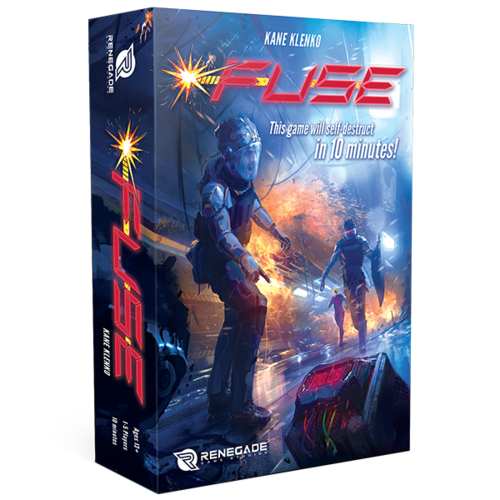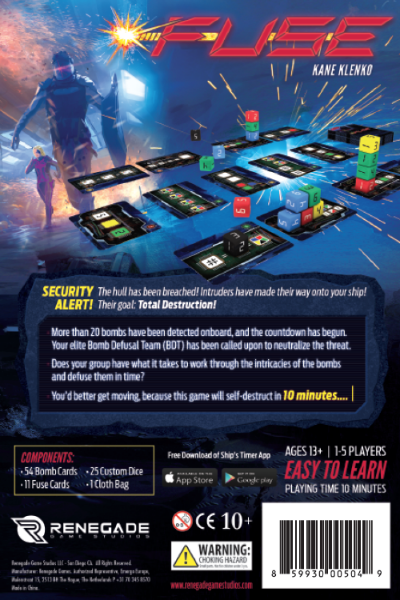Ten minutes may seem like a long time. Sometimes waiting ten minutes for the bus in the rain can seem like an eternity. Of course, if you’re defusing bombs, I have a feeling those ten minutes will fly right on by before you know it. In “Fuse”, players will be communicating and working together to defuse the required number of bombs (based on difficulty and number of players) before the timer runs out. Will you crack under the pressure, or successfully pull off this daring and virtually life threatening attempt?

Fuse: 1-5 Players, Ages 13+, Average Playing Time = 10 Minutes
Components
The game includes 25 Dice, 54 Bomb Cards, 22 FUSE Cards, 1 Large Dice Bag, 1 Rule Book, and a FREE Download – Ship’s Computer Timer app. If you cannot download the app, then any ten minute timer will do.
Setup & Gameplay
There are a number of ways to set up the game, depending on whether or not you’re using the advanced bomb cards or an alternate setup variant found in the manual. To keep things moving, I’ll opt to touch on the core rules without all the fluff, variants, and more difficult cards.
First, players will want to separate the bomb cards from the fuse cards, then take out the double stack and pyramid cards from the bomb deck (as they make the game more difficult). The bomb cards are shuffled and two are dealt out face-up to each player (in a solitaire game, deal four to yourself). The two that are dealt to each player must include at least one “1” or “2” point card (in a solitaire game, you must have three different value cards).
Then, a number of bomb cards are dealt to form the actual deck (based on difficulty and number of players) with the rest put back into the box. Five cards are drawn from that deck, face-up, to form a pool. Then, six random fuse cards are shuffled into the bomb deck. All twenty-five dice are placed in the bag and someone is chosen to receive said bag to be the starting player. If you don’t have the app, set any timer for ten minutes and begin when ready.
Once the game starts, the player with the bag of dice will draw one for each player in the game and roll them. Each player will then choose one, communicating as needed. In a two player game, four dice are drawn/rolled and each player receives two. In a solitaire game, draw/roll three. With the die or dice chosen, the players will place them onto their bomb cards within accordance to their rules. A “# – # = 2” card, for example, requires two dice whose difference equals two. Some spaces require a certain color or number, or perhaps either or. Stack and pyramid cards are a bit more difficult and require the dice to be arranged in a particular order.
If a die cannot be placed, it is rolled. Then, each player must remove one die on their bomb card that matches the color of the die or the number rolled. If a player completes a bomb card, it goes into a score pile and said player chooses a new card from the pool, drawing a new card from the deck to replace it. If a fuse card is drawn, it is instantly activated, discarded, and replaced with a new card. Fuse cards force players to discard dice on their bomb cards, based on the color or number shown.
The game continues with players drawing, choosing, and placing dice, passing the dice bag clockwise after every round. If they manage to defuse all the bombs before the timer runs out, they win! As a special note, players only need to defuse all the bombs from the middle of the table…the two in their possession, at the end of the game, turns out to be duds. Players can also score the cards and record their totals in the back of the rulebook.
Editor’s Note: The above doesn’t cover all of the rules found in the manual, but should give you an idea as to how the game is played.

The Review
As cooperative games go, this one is pretty fun. While the manual doesn’t mention this, you COULD increase your time limit to say, fifteen minutes to give yourself and your group a more casual experience. It’ll take away the suspense factor slightly, but it’ll no doubt appeal to the casual crowd and to those unfamiliar with the game. I don’t know about you, but I hate to feel rushed while learning how to play something. Alternatively, you could give yourself less time, though it’s easier to simply increase the difficulty level by adding more bomb cards.
I like that players have more ways to make the game more challenging, such as the inclusion of stack and pyramid cards. With these two types of cards, you’ll have to put the dice down in a particular order making it harder to complete them. There’s also a few variants listed in the back of the rulebook that suggest how the game could be set up differently. For example, players could seed the deck ahead of time with 1-4 point cards (4 being most difficult) as they see fit. For an easier time, they could include more 1-2 point cards. Next, the bomb cards could each go into their own pile sorted by point value or as a single deck as described in basic setup.
“Fuse” can be found for about $20-$25 (the price on Amazon as of 2/18/19), making it a fairly good buy if you’re into cooperative games that encourage a lot of communication. Timed games always bug me because I hate being rushed, but that can be easily resolved by adding more time to the timer (I prefer to use my iPhone’s built in clock timer as opposed to downloading the app, but that’s just me).
Final Verdict: 8/10
—
